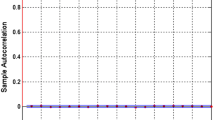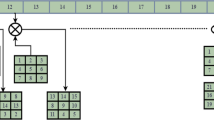Abstract
It is important to ensure the privacy and security of the medical images that are produced with electronic health records. Security is ensured by encrypting and transmitting the electronic health records, and privacy is provided according to the integrity of the data and the decryption of data with the user role. Both the security and privacy of medical images are provided with the innovative use of lightweight cryptology (LWC) and Walsh–Hadamard transform (WHT) in this study. Unlike the light cryptology algorithm used in encryption, the hex key in the algorithm is obtained in two parts. The first part is used as the public key and the second part as the user-specific private key. This eliminated the disadvantage of the symmetric encryption algorithm. After the encryption was performed with a two-part hex key, the Walsh–Hadamard transform was applied to the encrypted image. In the Walsh–Hadamard transform, the Hadamard matrix was rotated with certain angles according to the user role. This allowed the encoded medical image to be obtained as a vector. The proposed method was verified with the results of the number of pixel change rates and unified average changing intensity measurement parameters and histogram analysis. The results showed that the method is more successful than the lightweight cryptology method and the proposed methods in the literature to solve security and privacy of the data in medical applications with user roles.
Graphical Abstract





Similar content being viewed by others
References
Suzuki T, Emura K, Ohigashi T (2019) A generic construction of integrated secure-channel free PEKS and PKE and its application to EMRs in cloud storage. J Med Syst 43(5):128
Thakur S, Singh AK, Ghrera SP, Elhoseny M (2019) Multi-layer security of medical data through watermarking and chaotic encryption for tele-health applications. Multimed Tools Appl 78(3):3457–3470
Wu S, Du J (2019) Electronic medical record security sharing model based on blockchain. In Proceedings of the 3rd International Conference on Cryptography, Security and Privacy (pp. 13–17)
Suresh D, Florence ML (2019) Securing personal health record system in cloud using user usage based encryption. J Med Syst 43(6):171
Roy M, Mali K, Chatterjee S, Chakraborty S, Debnath R, Sen S (2019) A study on the applications of the biomedical image encryption methods for secured computer aided diagnostics. In 2019 Amity International Conference on Artificial Intelligence (AICAI), pp 881–886. IEEE
Chen WK, Tso HK (2013) Visual sharing protection method for medical images. J Med Syst 37(1):9900
Lima JB, Madeiro F, Sales FJ (2015) Encryption of medical images based on the cosine number transform. Signal Process Image Commun 35:1–8
Banik A, Shamsi Z, Laiphrakpam DS (2019) An encryption scheme for securing multiple medical images. J Inf Secur Appl 49:102398
Wadi SM, Zainal N (2014) High definition image encryption algorithm based on AES modification. Wirel Pers Commun 79(2):811–829
Tawalbeh LA, Mowafi M, Aljoby W (2013) Use of elliptic curve cryptography for multimedia encryption. IET Inf Secur 7(2):67–74
Zhang C, Li J, Wang S, Wang Z (2017) An encrypted medical image retrieval algorithm based on DWT-DCT frequency domain. In 2017 IEEE 15th International Conference on Software Engineering Research, Management and Applications (SERA), pp 135–141. IEEE
Anand A, Singh AK (2020) An improved DWT-SVD domain watermarking for medical information security. Comput Commun 152:72–80
Hafsa A, Gafsi M, Malek J, Machhout M (2021) FPGA Implementation of improved security approach for medical image encryption and decryption. Sci Program 2021
Wu J, Xie Z, Liu Z, Liu W, Zhang Y, Liu S (2016) Multiple-image encryption based on computational ghost imaging. Opt Commun 359:38–43
Bouslimi D, Coatrieux G, Roux C (2012) A joint encryption/watermarking algorithm for verifying the reliability of medical images: application to echographic images. Comput Methods Programs Biomed 106(1):47–54
Dzwonkowski M, Papaj M, Rykaczewski R (2015) A new quaternion-based encryption method for DICOM images. IEEE Trans Image Process 24(11):4614–4622
Kaur M, Kumar V (2018) Adaptive differential evolution-based Lorenz chaotic system for image encryption. Arab J Sci Eng 43(12):8127–8144
Kaaniche N, Laurent M (2017) Data security and privacy preservation in cloud storage environments based on cryptographic mechanisms. Comput Commun 111:120–141
Sneha PS, Sankar S, Kumar AS (2020) A chaotic colour image encryption scheme combining Walsh-Hadamard transform and Arnold-Tent maps. J Ambient Intell Humaniz Comput 11(3):1289–1308
Mishra Z, Acharya B (2020) High throughput and low area architectures of secure IoT algorithm for medical image encryption. J Inf Secur Appl 53:102533
Savima K (2020) A review on present light weight block cypher for IoT devices to reduce possible malware attacks. Purakala with ISSN 0971–2143 is an UGC CARE J 31(18): 490–508
Thakur S, Singh AK, Ghrera SP, Mohan A (2020) Chaotic based secure watermarking approach for medical images. Multimed Tools Appl 79(7):4263–4276
Clark K, Vendt B, Smith K, Freymann J, Kirby J, Koppel P, … Tarbox L (2013) The Cancer Imaging Archive (TCIA): maintaining and operating a public information repository. J Digit Imaging 26(6):1045–1057
Scarpace L, Flanders A, Jain R, Mikkelsen T, Andrews D (2015) Data from REMBRANDT. The cancer imaging archive. https://doi.org/10.7937/K9/TCIA.2015.588OZUZB
Chen M, Ma G, Tang C, Lei Z (2020) Generalized optical encryption framework based on Shearlets for medical image. Opt Lasers Eng 128:106026
Niyat AY, Moattar MH (2020) Color image encryption based on hybrid chaotic system and DNA sequences. Multimed Tools Appl 79(1–2):1497–1518
Ghebleh M, Kanso A (2019) A novel efficient image encryption scheme based on chained skew tent maps. Neural Comput Appl 1–16
Li C, Luo G, Qin K, Li C (2017) An image encryption scheme based on chaotic tent map. Nonlinear Dyn 87(1):127–133
Yin S, Liu J, Teng L (2020) improved elliptic curve cryptography with homomorphic encryption for medical image encryption. IJ Netw Secur 22(3):419–424
Krishnamoorthi R, Murali P (2014) Chaos based image encryption with orthogonal polynomials model and bit shuffling. In 2014 International Conference on Signal processing and Integrated Networks (SPIN), pp 107–112. IEEE
Fu C, Li WJ, Meng ZY, Wang T, Li PX (2013) A symmetric image encryption scheme using chaotic baker map and Lorenz system. In 2013 Ninth International Conference on Computational Intelligence and Security, pp 724–728. IEEE
Akkasaligar PT, Biradar S (2020) Selective medical image encryption using DNA cryptography. Inf Secur J Glob Perspect 29(2):91–101
Giudice A, Barone S, Muraca D, Averta F, Diodati F, Antonelli A, Fortunato L (2020) Can teledentistry improve the monitoring of patients during the COVID-19 dissemination? A descriptive pilot study. Int J Environ Res Public Health 17(10):3399
Talhaoui MZ, Wang X, Midoun MA (2021) A new one-dimensional cosine polynomial chaotic map and its use in image encryption. Vis Comput 37(3):541–551
Ravichandran D, Banu SA, Murthy BK, Balasubramanian V, Fathima S, Amirtharajan R (2021) An efficient medical image encryption using hybrid DNA computing and chaos in transform domain. Med Biol Eng Comput 59(3):589–605
Author information
Authors and Affiliations
Corresponding author
Ethics declarations
Ethics approval
This article does not contain any studies with human participants or animals performed by any of the authors.
Conflict of interest
The authors declare no competing interests.
Additional information
Publisher's note
Springer Nature remains neutral with regard to jurisdictional claims in published maps and institutional affiliations.
Rights and permissions
About this article
Cite this article
Kasim, Ö. Secure medical image encryption with Walsh–Hadamard transform and lightweight cryptography algorithm. Med Biol Eng Comput 60, 1585–1594 (2022). https://doi.org/10.1007/s11517-022-02565-5
Received:
Accepted:
Published:
Issue Date:
DOI: https://doi.org/10.1007/s11517-022-02565-5




